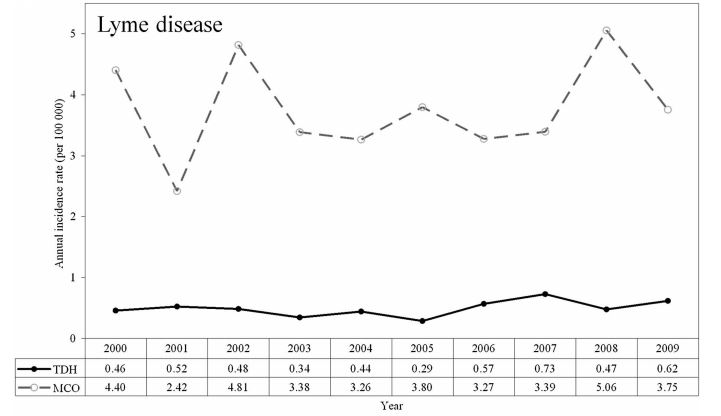Hundreds of Lyme disease patients in Tennessee

The incidence of Lyme disease (LD) in Tennessee was 7.7 times higher than that reported to the Tennessee Department of Health (TDH) from 2000–2009 in a study reported in the 2013 Journal of the American Medical Informatics Association. [1]
The study describes a significant problem with under-reporting (∼196 unreported cases per year) based on data from BlueCross BlueShield of Tennessee (BCBST), and the Center for Environmental and Communicable Diseases. The paper proposed using medically diagnosed cases from a Tennessee-based Managed Care Organization (MCO) to help bridge gaps in the surveillance system. (See table below.)
In a follow up study, the incidence of LD in Tennessee was 19 times higher than that reported to the TDH. [2] From January 2011 – June 2013, 1,367 cases of LD were identified in the BCBST database at a time when only 74 cases were identified by the TDH.
The authors reported that 50% of the patients sampled in the BCBST database had a history of Lyme disease. The authors did not have enough information on an additional 1/4 of the patients sampled to confirm if they had a history of LD.
The authors also reported that less than 4% of the patients’ sampled cases in the BCBST claims database met the national surveillance case definition for LD. The surveillance case definition required a combination of clinical (erythema migrans [EM] rash or late manifestation of disease), laboratory (positive results by immunoassay followed by positive western blot results), and exposure and endemicity (possible exposure to infected ticks <30 days before rash onset) evidence.
The authors did not concede the need to incorporate administrative medical claims data in the TDH surveillance system.
The Tennessee study offers some insight into the limits of their surveillance database. Hundreds of Lyme disease patients are missing from their surveillance database. Most LD patients are diagnosed using clinical judgment rather than the surveillance database.
Sources
- Jones SG, Coulter S, Conner W. Using administrative medical claims data to supplement state disease registry systems for reporting zoonotic infections. J Am Med Inform Assoc, (2012).
- Enhancing Lyme Disease Surveillance by Using Administrative Claims Data, Tennessee, USA Available from https://wwwnc.cdc.gov/eid/article/21/9/15-0344_article Last accessed 8/2/15.





Join the Lyme Conversation
(Note: comments are moderated. You will see your comment after it has been reviewed.)